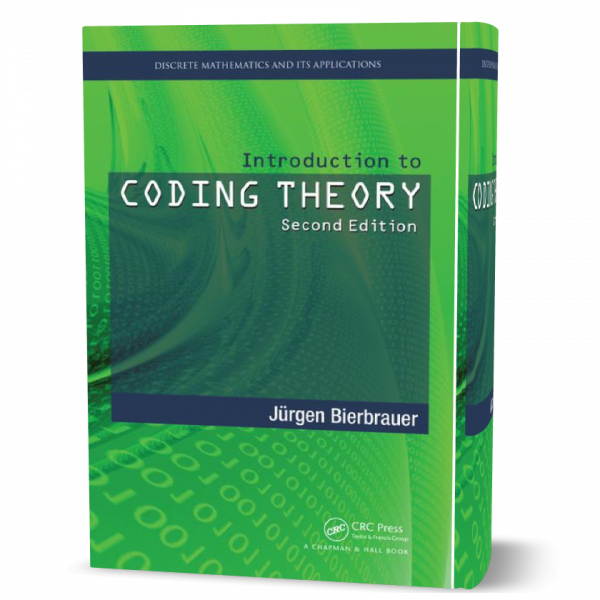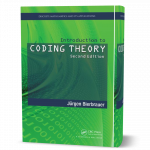Introduction to Coding Theory
Original price was: $125.00.$4.08Current price is: $4.08.
Published: 2017
Edition: 2th
Pages: 538
Type: pdf
Size: 2MB
Download After Payment
- Description
- Reviews (0)
Description
Description
The theory of error-correcting codes is a branch of discrete mathematics with close ties to other mathematical disciplines, like design theory, combinatorial theory, linear algebra, finite fields, rings, Galois geometry, geometric algebra, algebraic curves over finite fields, and group theory. The best-known application is in the transmission of messages over noisy communication channels. Other fields of application are to be found in statistics (design of experiments) in download free Introduction to Coding Theory – Jurgen Bierbrauer 2nd edition book in pdf format . for more computer ebooks click here
cryptography (authentication, the design of ciphers) and in many areas of theoretical computer science. In this textbook, we present a self-contained introduction to mathematical coding theory and to its major areas of application. High school algebra and some exposition to basic linear algebra are sufficient as mathematical background. Part I is designed for use in a one-semester undergraduate course. A second semester would start with the theory of cyclic codes. In Part II of download free Introduction to Coding Theory – Jurgen Bierbrauer 2nd edition book in pdf format the emphasis is on cyclic codes, applications of codes, linear programming bounds, and the geometric description of linear codes.
Introduction to Coding Theory – Jurgen Bierbrauer 2nd edition
The mathematical tools are developed along the way. Part III of download free Introduction to Coding Theory – Jurgen Bierbrauer 2nd edition book in pdf format offers a brief introduction to some of the basics of the theory of function fields in one variable (algebraic curves) over a finite field of constants, basic construction of codes (algebraic-geometric codes), and the properties of some interesting families of examples.
The historical origins of the coding theory are in the problem of reliable communication over noisy channels. This is a typical problem of the discipline now called Information Theory. Both disciplines, Coding Theory and Information Theory originated with Claude Shannon’s famous 1948 paper [183).
It contains the celebrated channel coding theorem (see Chapter 9 of download free Introduction to Coding Theory – Jurgen Bierbrauer 2nd edition book in pdf format) which states roughly that good long codes are guaranteed to exist, without giving a clue how to construct them. Closely related is the development of Cryptography. Its aim is to ensure reliable communication in the presence of ill-willed opponents. These problems are rather different. In the coding theory scenario, we have to overcome a technical problem (the shortcomings of a communication channel), whereas in Cryptography we have to beat an opponent. Nonetheless, the mathematical tools used in these two areas have a large intersection.
Chapters content of this book
Historically the development of both disciplines was boosted by the efforts of World War II. Another famous paper by Claude Shannon. from 1949, is perceived as the origin of modern cryptography. The information-theoretic problem prompted the definition of a mathematical structure called error-correcting code or simply code. Coding theory can be seen as the study of error-correcting codes, their construction, bounds on their parameters, their implementation, and so forth. The most important parameter is the minimum distance. It measures the code’s capability of correcting transmission errors.
Progress in coding theory was slow but steady. One important development was the theory of cyclic codes, which is traditionally couched in the language of ring theory. Cyclic codes are particularly useful because they admit a fast decoding algorithm. The theory of cyclic codes is a core topic of Part II download free Introduction to Coding Theory – Jurgen Bierbrauer 2nd edition book in pdf format .
It is developed in Chapter 13 of download free Introduction to Coding Theory – Jurgen Bierbrauer 2nd edition book in pdf format, preceded by an introduction to some relevant features of finite fields in Chapter 12. Our approach is different from the traditional approach. It is based on the trace and the action of the Galois group. Ring theory does not come into play at all. Only the single most famous cyclic code, the binary Golay code, is introduced in Part I, along with a closely related structure, the large Witt design (Chapter 7).
more description download free Introduction to Coding Theory book
The ties between coding theory and several areas of pure mathematics have grown stronger all the time. The most important insight goes back to the early 1980s. It is the discovery, by Goppa and Manin (97, 138), of a close relationship between codes and algebraic curves (in algebraic language function fields). Algebraic curves are objects of number theory and algebraic geometry, mainstream mathematical disciplines with a long and rich history. The observation by Goppa and Manin makes it possible to use these number-theoretic tools for the construction of codes. The theory of those algebraic-geometric codes (AG-codes) is the objective of Part İIII download free Introduction to Coding Theory – Jurgen Bierbrauer 2nd edition book in pdf format .
In fact, we develop only some of the basics of the theory of algebraic curves with finite fields of constants, just enough to understand the basic construction of algebraic-geometric codes and to study some interesting families of examples in download free Introduction to Coding Theory – Jurgen Bierbrauer 2nd edition book in pdf format .
Coding theory and combinatorics are closely connected. As an example, block designs are important objects of modern discrete mathematics. For more information see the CRC Handbook of Combinatorial Designs [106]. We will encounter them repeatedly in the text. A formal definition is in Chapter 7, where we also derive the large Witt design from the binary Golay code. Other examples of block designs in the text include projective planes, projective and affine geometry over finite fields (Chapter 17), the small Witt design, which is derived from the ternary Golay code in Section 17.1, and the Denniston arcs in the same section.
Table of content of Coding Theory 2nd edition book in pdf format
Linear codes can be equivalently described as sets of points in projective spaces. In many cases, the geometric language is more appropriate than the algebraic approach. In Part I we study 3 dimensional codes from this point of view (Chapter 10). This case is particularly easy to understand as the underlying geometrical structures are classical projective planes PG(2.q). The general mechanism is developed and used in Chapter 17 of download free Introduction to Coding Theory – Jurgen Bierbrauer 2nd edition book in pdf format .
In many cases, this leads to a better understanding of the codes. For instance, we use the geometric method to construct the ternary Golay code in Section 17.1. As a natural generalization, the additive codes (network codes) of Chapter 18 are described geometrically by families of subspaces of a fixed projective space. As a special case, the binary quantum codes of Chapter 18 are described by families of lines in binary projective spaces.
Caps are sets of points in projective or affine geometry no three of which are on a line. They are formally equivalent to linear codes of minimum distance d = 4. It turns out that caps are best understood from a geometric point of view. This is why we study caps in Chapter 17 of download free Introduction to Coding Theory – Jurgen Bierbrauer 2nd edition book in pdf format . The case of caps in projective planes and 3-spaces leads to another link with classical algebra. In fact, parabolic and elliptic quadrics yield canonical examples of caps in those dimensions. We include a self-contained introduction to geometric algebra in Section 17.2 which gives a better understanding of those caps.
download free Introduction to Coding Theory book in pdf format
Á general algebraic mechanism for the derivation of bounds is related to orthogonal polynomials (in the case of codes these are the Kravchuk polynomials) and linear programming. There is general linear programming bound. All the bounds used in the text, with the exception of the Griesmer bound, are special cases of the LPbound. Chapter 15 is a self-contained introduction to linear programming and contains unified proofs for all those explicit bounds on codes and orthogonal arrays. On the level of LP-bounds, there is a relation of duality between bounds on codes and bounds on orthogonal arrays. This is another reason why the notion of an orthogonal array should be seen as the dual of the notion of an error-correcting code, even in the nonlinear case.
This leads us to applications of codes. Traditionally coding theorists are biased towards the information-theoretic application that we encounter so often in this text. It still is one of the major applications. We use it as a motivation in the early chapters, discuss syndrome decoding in Chapter 3 and the decoding algorithm of BCH-codes based on the Euclidean algorithm in Chapter 13 of download free Introduction to Coding Theory – Jurgen Bierbrauer 2nd edition book in pdf format.
There is, however, a plethora of applications of a completely different nature. Many of them have surfaced in theoretical computer science, in particular in cryptography. Universal hash families yield a nice paradigmatic example. One version is presented in Part I, Chapter 6, while a more in-depth treatment is in Chapter 16. This chapter is dedicated to applications altogether. They range from statistics and cryptography to numerical integration and the theory of algorithms.







Reviews
There are no reviews yet.